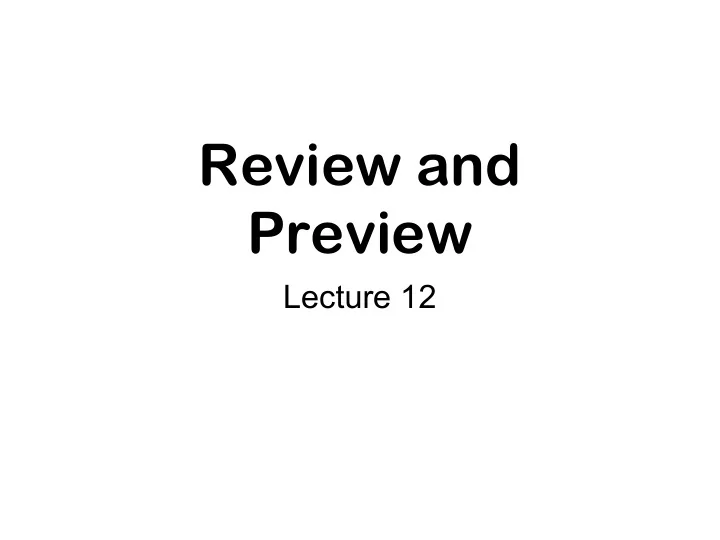

Review and Preview Lecture 12
Further Topics in Compilers • Advanced Language features • Object-Oriented Languages • objects, classes • Functional Languages • function closures • lazy evaluation • advanced type systems • parametric polymorphism (ML, Haskell) • subtyping (O-O languages) • modules • continuations, coroutines, threads
Further Topics in Compilers • data flow and control flow analysis • constant folding • inlining functions • loop optimization • hoisting code out of loops, loop unrolling • instruction selection • instruction scheduling • array bounds checks • delay slots, speculative execution • instruction level parallelism (ILP), pipelining, function units
Intermediate Languages • Static Single-Assignment form • IR as functional language • Continuation-Passing Style (CPS) • A-normal form • making important structure explicit • Typed intermediate languages • FLINT, TILT, TAL, ... • Virtual machine systems (JVM, MSIL) • JIT compilers
Runtime Systems • Memory management • garbage collectors • mark-sweep (classical) • copying, generational, incremental, compacting • Traps and interrupts • Input/Output • OS services • Threads
Review • Lexical Analysis • turning characters into tokens • regular expressions • NFAs and DFAs • lex (ml-lex) • r.e. patterns, actions • start states • handling strings with escapes • handling nested comments
Parsing • Context-free grammars • Top-down parsers • recursive descent • Bottom-up parsers • LR grammars (LR(k), SLR, LALR(k)) • constructing parser tables • Yacc (ml-yacc) • terminals and nonterminals • grammar rules and actions • shift-reduce and reduce-reduce conflicts • precedence and associativity declarations
Abstract Syntax • Simple tree representation of logical structure • types • expressions • statements • declarations • Naturally expressed using ML datatypes • Basis for semantic (or static) analysis
Type Checking • Types • express structure of data • interface of functions • Type Environments • map names (variables, functions) to their types • Typing rules • relate expressions and types • Type checking • check consistency • synthesize types of expressions
Semantic Analysis • Type checking • Determining scope of names (types, variables, functions) • Escape analysis • global vs local variables • Forward references • recursive types • recursive functions • two pass analysis (prebind names, then analyze definitions)
Intermediate Representation • Intermediate language or IR (tree.sig/sml) • a lower-level tree representation of program structure • constructs similar to machine language • unlimited supply of temps, or abstract registers • temps and labels replace variables and functions • conditional and unconditional jumps express control flow constructs (if-then-else, while, for, break) • type lexp expresses memory accesses (l-values, r-values) • MOVE represents assignment, indexing, selection
Translation of Absyn to IR • translation environments • maps names (variables and functions) to access info • separate expressions and statements • gexp reunifies expressions, statements, and conditionals • coercions between different forms to satisfy context • recursive traversal of abstract syntax (similar to type checking, escape analysis) • two pass treatment of recursive function declarations • types not involved • units of translation are “fragments” • representing single function body (or top-level program)
Function Call Frames • Call Frames (aka Activation Records) • store local information associated with a function call • arguments and local variables that “escape” • saved $fp and $ra registers • space for spilled temps and callee saves registers • space for excess outgoing arguments (beyond first 4) • frame record • records information about function and its frame layout during compilation • manages allocation of slots for arguments, locals, spills • could store info on use of global variables and need for static link
Static Links • Need to compute access to nonlocal variables • static link is frame pointer of frame of statically enclosing function • passed to function as additional, implicit parameter • not always needed • first argument, treated as escaping (found in 0($fp)) • computed with the aid of “level” type • chain of statically nested functions • translation environment maps function to its parent’s level
Basic Blocks & Trace Scheduling • Linearize code • move statements (including calls) out of expressions • no side effects in expressions • flatten to statement list (possibly followed by final expression) • eliminates SEQ and ESEQ IR tree forms • Split into basic blocks • straight-line code segments • start with label, end with (conditional or unconditional) jump • can be reordered without changing behavior • Trace scheduling • sort basic blocks and concatenate them • arrange so jumps are followed by target labels when possible • arrange for false branch of cond. jump to follow jump
Liveness Analysis • live range • a temp is live over a sequence of instructions between a definition and a use of that temp • liveness analysis determines the live ranges of temps • calculates live-in and live-out sets of temps at each instruction • two temps interfere if they are both live at the same point • they then have to coexist, and therefore can’t occupy the same register • t1 and t2 interfere if t1 is defined at an instr and the other is live-out at that instr • interference graph records interference relation • nodes represent temps, edges represent interference
Register Allocation • Assign registers (strings) to temps (allocation) • Avoid assigning same register to temps that interfere • color the interference graph using registers as colors • successively remove nodes of insignificant degree ( simplify ) • color them as they are restored • pick colors to maximize number of moves between temps of same color (these moves can then be eliminated) • If no nodes of insignificant degree • choose a node of minimal spill cost to spill (store in frame) • rewrite code to accomplish spilling • redo liveness analysis and interference graph coloring • Register coallescing • attempt ot coallesc nodes that are move related, if it doesn’t make coloring harder
Final Exam • Open book, open notes, open code • Wednesday, June 11, 10:30am-12:30pm
Recommend
More recommend